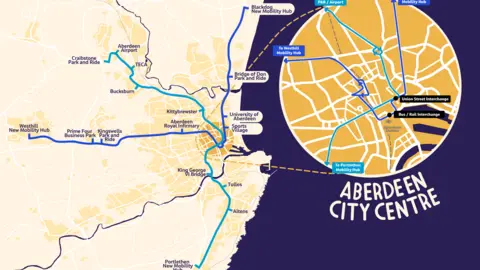City's rapid transit scheme cost could hit £323m
 Nestrans
NestransA proposed new tram-style bus system for Aberdeen could cost as much as £323m, according to a new report.
It is hoped Aberdeen Rapid Transit (ART) would run on two routes linking key destinations in and around the city.
The projected price of the project has more than doubled since initial investigations in 2021 - due to increased cost pressures, including a huge rise in construction costs.
Councillors on Aberdeen's net zero, environment and transport committee voted to move forward with engagement on the scheme and officers will report back on progress next year.
It had been initially anticipated the project would cost £150m to implement.
Now four options have been outlined by transport partnership Nestrans ranging from £167m to £323m.
The lower cost option would require less new infrastructure, while the highest cost option would see the project in a fuller form including more construction and integrated cycling provision.
Funding for the project remains unclear but sources such as a Scottish government transport scheme, local authority funding, and cash through the Aberdeen City Region Deal have been identified as options.
The council said it was investigating where it could get the money from, including from the UK government.
 Nestrans
NestransIt is hoped ART could use tram-style vehicles which would travel along designated corridors, similar to Belfast's Glider buses.
It is expected 36 of these electric vehicles would need to be purchased at an anticipated cost of about £30.2m.
Concerns were raised during Tuesday's committee meeting about the value for money of the plans.
Independent councillor Alex Nicoll said based on data in the report which suggested the scheme would bring in an extra 8,900 public transport users in the city, the project could cost more than £36,000 per extra passenger.
He added: "We are speaking about £3.4m being committed by the council so far, without even a shovel in the ground.
"We need to think about what we can actually deliver here, this council cannot afford it and it is that simple."
However, project lead Kirsty Chalmers insisted bringing ART in would be good value for money.
She said: "One of the reasons we are looking into this is the better value of it, instead of implementing light rail for example.
"The ART project covers a number of regionally-important destinations and it is about creating choice and it is about it integrating with the bus and rail networks as well."
